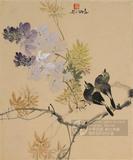清吳昌碩篆書七言聯 軸
推薦分享
資源連結
連結到原始資料 (您即將開啟新視窗離開本站)後設資料
- 資料識別:
- 贈書000386N000000000
- 資料類型:
- 類型:書法
- 型式:文字
- 著作者:
- 吳昌碩
- 出版者:
- 數位化執行單位:國立故宮博物院
- 格式:
- 本幅 132x32.4公分、全幅 39.8公分
- 語言:
- 漢文
- 關聯:
- 蔡辰男先生捐贈書畫目錄,頁21、119 &*吳昌碩(西元一八四四-一九二七年),浙江安吉人。初名俊,字昌碩,又字倉石,別號缶廬、苦鐵等。杭州西泠印社首任社長,近代金石書畫大師。廣收博取,閱歷眾多。書法以石鼓文見長,以探古為革新,變前人成法,雜揉鐘鼎陶器古文體勢,蒼勁樸茂,遒潤峻險,起落跌宕,氣魄雄渾,獨具風骨。本幅集石鼓文為上下聯:「多駕鹿車游汗澫。寫來鯉簡識平安。」是一九二七年,八十四歲的晚年之作。(20110101)&*Wu Changshi (native to Anji, Zhejiang) originally went by the name Jun and the style names Changshi and Cangshi. He also had the sobriquets Foulu, Kutie, Pohe, Laofou, and Dalong. Wu was leader of the Xiling Seal Carving Society in Hangzhou and a master of painting and calligraphy in the Bronze and Stone School. Widely learned, he specialized in calligraphy related to the Stone Drum script, plumbing the depths of antiquity for innovation and transforming the methods of the ancients. He combined the script forces on bronzes and ceramics from antiquity, creating a strong and forceful style also simple and rich. His bold and moist yet incisive manner rises and falls freely with great power that gives his works unique style and character. This couplet of auspicious contents is a compilation of characters from the Stone Drum inscriptions. Done in 1927, it is a very late work by Wu from the Chinese age of 84. This work was donated to the National Palace Museum by Mr. Ts'ai Ch'en-nan.(20110101)&*呉昌碩(1844-1927)、浙江安吉の人。本名は俊、字は昌碩、または倉石、別号は缶廬、苦鉄など。杭州西泠印社(中国近代の学術団体)初代社長、近代金石書画の大家。幅広く学び、様々な経験を積んだ。書法は石鼓文に優れ、古典の探求から革新的なものを生み出し、前人が築いた既定のやり方を変革し、鐘、鼎、陶器の古文の風格を混ぜ合わせた。その作風は質朴として力強く、たっぷりと豊かだが峻厳さも併せ持ち、変化と抑揚に富み、雄渾な気魄に満ちており、独特の趣が感じられる。本作は石鼓文を集めたもので、上下の聯になっている。「多駕鹿車游汗澫。写来鯉簡識平安。」-1927年、呉昌碩84歳、晩年の作である。(20110101)
- 管理權:
- 國立故宮博物院
授權聯絡窗口
- 國立故宮博物院圖像授權、出版授權、影音資料授權-申請流程說明
http://www.npm.gov.tw/zh-TW/Article.aspx?sNo=03003061






